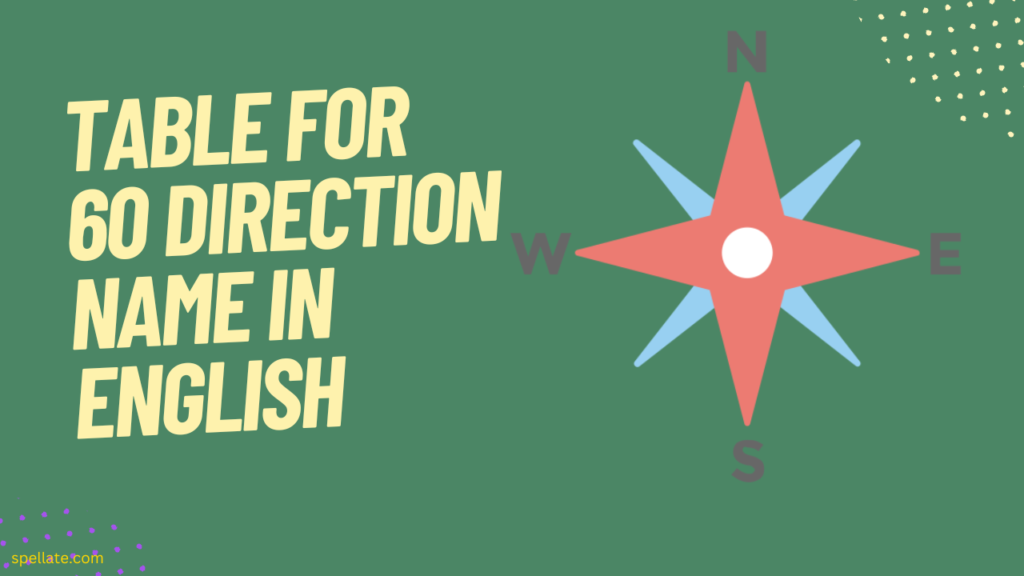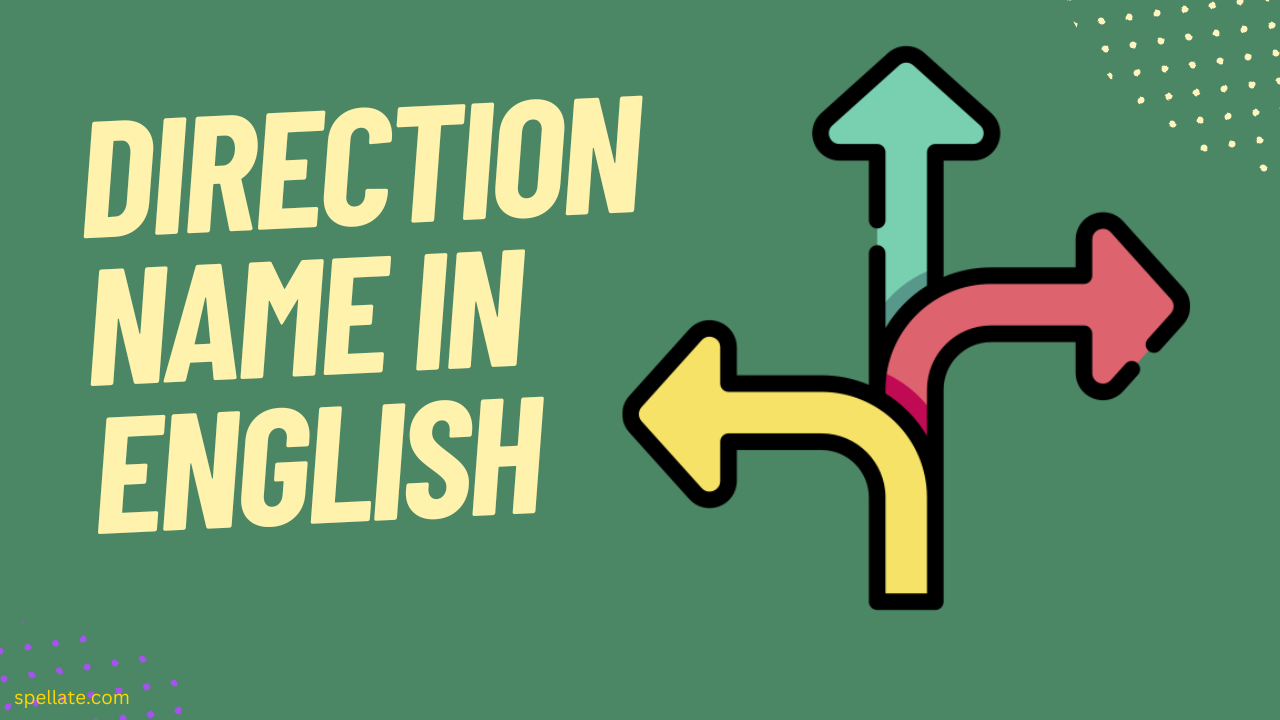Directions are words or phrases that describe the spatial relationship between two or more objects or locations. In English, there are four main directions: North, South, East, and West. These four directions are known as the cardinal directions and are used to describe locations on a map or to give directions to someone.
North is the direction towards the Earth’s North Pole, while South is the direction towards the Earth’s South Pole. East is the direction towards the Earth’s rotation, and West is the opposite direction. These directions are also used in combination to describe the diagonal directions, such as Northeast, Southeast, Southwest, and Northwest.
Direction Name In English are essential in everyday life, especially for navigation purposes. They are used to give and receive directions, whether it be for driving, walking, or even sailing. Directions are also used in aviation, where pilots rely on compass headings to navigate the skies.
In addition to the cardinal directions, there are other terms used to describe directions. For example, “up” and “down” describe the vertical direction, while “left” and “right” describe the horizontal direction. These terms are also used in combination to describe the diagonal directions, such as up and to the right, or down and to the left. Overall, directions are an essential part of our daily lives, and knowing how to use and understand them is important for effective communication and navigation.
List of direction name in English

When it comes to giving or following directions, having a good knowledge of direction name in English is essential. These names not only help you understand where something is located but also make it easier for you to communicate your location to others. In this article, we have compiled a list of common direction names used in the English language.
North:
North is the direction that points towards the Earth’s North Pole. It is the opposite direction to South and is located at the top of most maps. In the northern hemisphere, North is the direction in which a compass needle points, as it aligns with the Earth’s magnetic field. North is used in combination with other directions to describe diagonal directions, such as Northeast or Northwest.
South:
South is the direction that points towards the Earth’s South Pole. It is the opposite direction to North and is located at the bottom of most maps. In the southern hemisphere, South is the direction in which a compass needle points, as it aligns with the Earth’s magnetic field. South is used in combination with other directions to describe diagonal directions, such as Southeast or Southwest.
East:
East is the direction that points towards the Earth’s rotation. It is the direction in which the sun rises and is located on the right side of most maps. In the northern hemisphere, East is to the right of North, while in the southern hemisphere, East is to the left of North. East is used in combination with other directions to describe diagonal directions, such as Northeast or Southeast.
West:
West is the direction that is opposite to East, and it is the direction in which the sun sets. It is located on the left side of most maps in the northern hemisphere, while in the southern hemisphere, it is located on the right side of most maps. West is used in combination with other directions to describe diagonal directions, such as Northwest or Southwest.
Northeast:
Northeast is the direction that is halfway between North and East. It is the direction that is located in the upper-right quadrant of a map. It is used to describe a location that is towards the north and the east of a reference point. For instance, if you are standing facing North, then the Northeast direction would be to your right.
Northwest:
Northwest is the direction that is halfway between North and West. It is the direction that is located in the upper-left quadrant of a map. It is used to describe a location that is towards the north and the west of a reference point. For instance, if you are standing facing North, then the Northwest direction would be to your left.
Southeast:
Southeast is the direction that is halfway between South and East. It is the direction that is located in the lower-right quadrant of a map. It is used to describe a location that is towards the south and the east of a reference point. For instance, if you are standing facing South, then the Southeast direction would be to your right.
Southwest:
Southwest is the direction that is halfway between South and West. It is the direction that is located in the lower-left quadrant of a map. It is used to describe a location that is towards the south and the west of a reference point. For instance, if you are standing facing South, then the Southwest direction would be to your left.
Up:
Up is the direction that is opposite to Down. It is used to describe a location that is higher than a reference point. For instance, if you are standing on the ground, then the Up direction would be towards the sky. The Up direction is used in combination with other directions to describe diagonal directions, such as Up and to the Right or Up and to the Left.
Down:
Down is the direction that is opposite to Up. It is used to describe a location that is lower than a reference point. For instance, if you are standing on the ground, then the Down direction would be towards the earth. Down is used in combination with other directions to describe diagonal directions, such as Down and to the Right or Down and to the Left.
Left:
Left is the direction that is opposite to Right. It is used to describe a location that is towards the left of a reference point. For instance, if you are facing North, then the Left direction would be to your West. Left is used in combination with other directions to describe diagonal directions, such as Northwest or Southwest.
You May Also Like
Right:
Right is the direction that is opposite to Left. It is used to describe a location that is towards the right of a reference point. For instance, if you are facing North, then the Right direction would be to your East. Right is used in combination with other directions to describe diagonal directions, such as Northeast or Southeast.
Table for 60 direction name in english

As the English language continues to evolve, so does its vocabulary. And with new words and phrases being added every year, it’s no surprise that there are now countless direction names in English. From North to South, East to West, and everything in between – there is a direction for every purpose. Here’s a table of the 60 direction name in English:
| Cardinal Directions | Diagonal Directions |
| North | Northeast |
| South | Southeast |
| East | Southwest |
| West | Northwest |
| Intermediate Directions | Ordinal Directions |
| North-Northeast | First North, then Northeast |
| East-Northeast | First East, then Northeast |
| East-Southeast | First East, then Southeast |
| South-Southeast | First South, then Southeast |
| South-Southwest | First South, then Southwest |
| West-Southwest | First West, then Southwest |
| West-Northwest | First West, then Northwest |
| North-Northwest | First North, then Northwest |
| 16-wind compass rose | |
| North | |
| North-Northeast | |
| Northeast | |
| East-Northeast | |
| East | |
| East-Southeast | |
| Southeast | |
| South-Southeast | |
| South | |
| South-Southwest | |
| Southwest | |
| West-Southwest | |
| West | |
| West-Northwest | |
| Northwest | |
| North-Northwest | |
| 32-wind compass rose | |
| North | |
| North by East | |
| North-Northeast | |
| Northeast by North | |
| Northeast | |
| Northeast by East | |
| East-Northeast | |
| East by North | |
| East | |
| East by South | |
| East-Southeast | |
| Southeast by East | |
| Southeast | |
| Southeast by South | |
| South-Southeast | |
| South by East | |
| South | |
| South by West | |
| South-Southwest | |
| Southwest by South | |
| Southwest | |
| Southwest by West | |
| West-Southwest | |
| West by South | |
| West | |
| West by North | |
| West-Northwest | |
| Northwest by West | |
| Northwest | |
| Northwest by North | |
| North-Northwest | |
| North by West |
The impact of direction names on culture

Direction names have a significant impact on culture as they shape how people perceive and navigate the world around them. The way a culture conceptualizes and names directions can influence various aspects of society, including language, spatial orientation, social interactions, and even cognitive processes. Here are some key ways in which direction names impact culture:
Linguistic Influence:
Direction names are an integral part of language and affect the way people communicate and express spatial relationships. Different cultures have diverse systems for describing directions. For example, some languages, like English, primarily use cardinal directions (north, south, east, west), while others, such as the Guugu Yimithirr language spoken by indigenous Australians, rely on cardinal directions in everyday communication. This linguistic influence shapes how individuals think about and relate to space.
Spatial Perception:
The direction names used in a culture can affect how people perceive and conceptualize space. Cultures that use cardinal directions extensively tend to have a heightened sense of orientation and are more skilled in spatial cognition. In contrast, cultures that rely on landmarks or relative directions may prioritize different spatial cues and have distinct cognitive maps.
Cultural Identity and Heritage:
Direction names often have cultural and historical significance. They can be rooted in local geography, natural features, celestial observations, or historical events. Such names can reinforce cultural identity, preserve indigenous knowledge, and create a sense of belonging among community members. For example, indigenous cultures may have direction names tied to specific locations, sacred sites, or ancestral connections.
Social Interaction and Communication:
The use of direction names impacts social interactions and communication patterns. In cultures that rely heavily on cardinal directions, individuals may provide orientation or navigational instructions using these terms. This shared understanding facilitates efficient communication and enables people to give precise directions. It can also affect social norms, such as how people orient themselves during conversations or how seating arrangements are organized in specific contexts.
Environmental Awareness and Sustainability:
Direction names can promote environmental awareness and sustainability practices. Cultures that emphasize cardinal directions often have a deep connection to the natural environment and understand its interconnections. This knowledge can influence ecological practices, land management, and sustainable resource use, as well as foster a sense of responsibility toward the environment.
Navigation and Wayfinding:
The choice of direction names influences navigation and wayfinding strategies within a culture. Different naming systems can impact how individuals navigate through their surroundings, whether by using cardinal directions, landmarks, or other spatial references. Cultural practices and traditions related to navigation, such as celestial navigation or the use of environmental cues, may also be influenced by direction names.
Tips for Remembering Direction Names
Use mnemonics: Create a memorable phrase or sentence that contains the direction names in order. For example, “Never Eat Soggy Waffles” can help you remember the order of North, East, South, and West.
Associate directions with landmarks: Associate each direction with a landmark or object that is located in that direction. For example, you could associate North with the North Star or the top of a compass.
Visualize directions on a map: Look at a map and visualize the directions in relation to the features on the map. This can help you remember which direction is which.
Use technology: Many smartphones have built-in compasses that can show you which direction you are facing. You can also use GPS and mapping apps to help you navigate and become more familiar with direction names.
Practice using directions: Practice giving and receiving directions using the correct direction names. This can help you become more familiar with the names and their meanings.
Break directions down into smaller groups: Instead of trying to remember all the directions at once, focus on learning the cardinal directions first, then move on to the intermediate and ordinal directions.
Final Thoughts
In conclusion, understanding direction name in English is an important skill for navigation, communication, and everyday life. The four cardinal directions (North, South, East, and West) are the most basic directions, while the intermediate directions (Northeast, Southeast, Southwest, and Northwest) and ordinal directions provide more specific locations.
There are also different systems for naming and dividing directions, such as the 16-wind compass rose and 32-wind compass rose, which are used in navigation and meteorology. By using techniques such as mnemonics, visualizing directions, and practicing giving and receiving directions, anyone can become familiar with direction names and improve their ability to navigate and communicate effectively.
FAQs
How are direction names used in English communication?
Direction names are used in English communication to describe spatial relationships and provide orientation. They are used in giving directions, describing locations, and indicating movement or position.
How do English direction names compare to other cultures’ direction names?
English direction names are primarily based on cardinal directions, while other cultures may use different systems based on local geography, celestial observations, or cultural traditions. For example, some indigenous cultures use cardinal directions in everyday communication, while others may use landmarks or relative directions.
Are there any cultural implications of English direction names?
Yes, the use of cardinal directions name in English may influence spatial perception, navigation strategies, and environmental awareness. It may also reflect the cultural values of precision, efficiency, and objectivity.
